
Browse an alphabetical list of photographs. These historical images portray people, places, and events before, during, and after World War II and the Holocaust.
<< Previous | Displaying results 51-100 of 2641 for "Photo" | Next >>
A Czech woman who witnessed the Nazi massacre of the male inhabitants of Lidice is sworn in at the RuSHA trial in Nuremberg, case #8 of the Subsequent Nuremberg Proceedings. Germany, October 30, 1947.
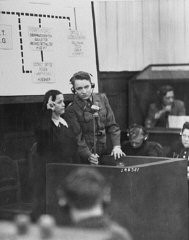
Panel from the exhibition A Dangerous Lie: The Protocols of the Elders of Zion which was on display at the United States Holocaust Memorial Museum from 2006–18. The exhibition explored the continuing impact of the most widely distributed antisemitic publication of modern times.
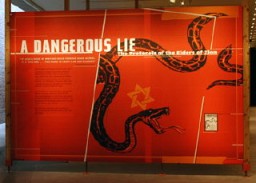
An emaciated child eats in the streets of the Warsaw ghetto. Warsaw, Poland, between 1940 and 1943.
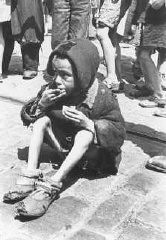
A display advertising the 11th Summer Olympic Games which were held in Berlin, Germany, 1936.
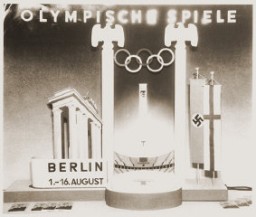
A Dutch survivor of the Ohrdruf camp shows the camp's gallows, which the Germans used to execute prisoners, to US forces (including Generals Eisenhower, Bradley, and Patton). Germany, April 12, 1945.
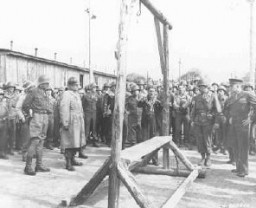
A family stands outside of their wagon while interned in a Zigeunerlager ("Gypsy camp"). In the background, children are crowded around Eva Justin. Justin worked for the Center for Research on Racial Hygiene and Demographic Biology. Schleswig-Holstein, Germany, 1938. During the Nazi era, Dr. Robert Ritter was a leading authority on the racial classification of people pejoratively labeled “Zigeuner” (“Gypsies”). Ritter’s research was in a field called eugenics, or what the Nazis called…
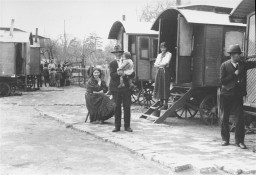
A family of Macedonian Jews in the Tobacco Monopoly transit camp in Skopje before deportation. Skopje, Yugoslavia, March 1943. The Jews of Bulgarian-occupied Thrace and Macedonia were deported in March 1943. On March 11, 1943, over 7,000 Macedonian Jews from Skopje, Bitola, and Stip were rounded up and assembled at the Tobacco Monopoly in Skopje, whose several buildings had been hastily converted into a transit camp. The Macedonian Jews were kept there between eleven and eighteen days,…
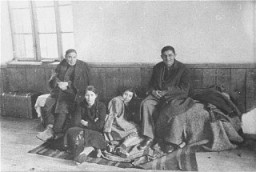
Frieda Greinegger during a family outing to a park in the mid-1930s. Frieda would later spend almost two years in the Ravensbrück concentration camp as punishment for consorting with a Polish forced laborer, Julian Noga. Austria, ca. 1935.
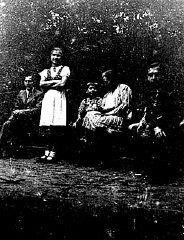
Portrait of a gay couple. Berlin, Germany, ca. 1930. Nazi ideology identified a multitude of enemies and led to the systematic persecution and murder of many millions of people, both Jews and non-Jews. The Nazis posed as moral crusaders who wanted to stamp out the "vice" of homosexuality from Germany in order to help win the racial struggle. Once they took power in 1933, the Nazis intensified persecution of German male homosexuals.
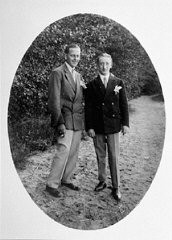
A German Jewish prisoner named Rosenthal pushes a cart in the stone quarry of the Im Fout labor camp in Morocco. The camp housed a group of foreign workers, many of whom fell ill because of poor living conditions. Im Fout, Morocco, 1941-42.
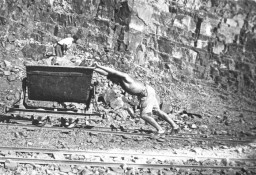
A German soldier stands guard on the eastern front. Soviet Union, February 28, 1944.
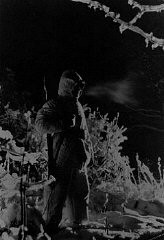
A German soldier stands on a toppled Polish monument. Krakow, Poland, 1940. This statue commemorated the Polish victory at Grunwald over the Teutonic knights in 1410. In accordance with the plans of German occupation authorities in Poland, all physical symbols of Polish national culture were to be obliterated to make way for the "Germanization" of the country.
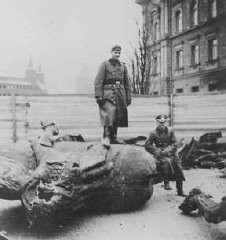
A German teacher singles out a child with "Aryan" features for special praise in class. The use of such examples taught schoolchildren to judge each other from a racial perspective. Germany, wartime.

In Berlin, a German woman reads a copy of the Berliner Illustrierte newspaper, featuring photographs of Mussolini's official visit to Berlin in September 1937.
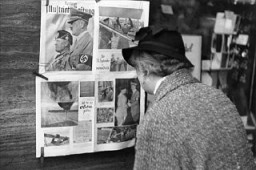
Sofia Karpuk holds a name card intended to help any of her surviving family members locate her at the Kloster Indersdorf displaced persons camp. This photograph was published in newspapers to facilitate reuniting the family. Kloster Indersdorf, Germany, October-November 1945.
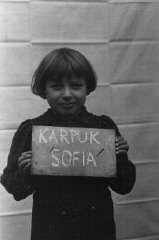
A group of children assembled for deportation to Chelmno. During the roundup known as the "Gehsperre" Aktion, the elderly, infirm, and children were rounded up for deportation. Lodz, Poland, September 5-12, 1942.

A group of children in the Kovno ghetto in Lithuania. This photograph was taken by George Kadish between 1941 and 1943.
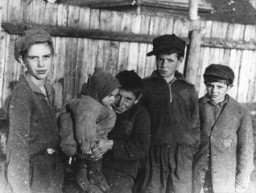
A group of Jehovah's Witnesses in their camp uniforms after liberation. These men were imprisoned in the Niederhagen bei Wewelsburg concentration camp. Niederhagen bei Wewelsbug, Germany, 1945.
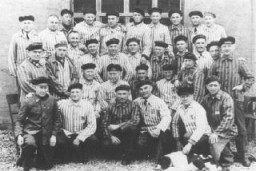
A group of Jewish men on a train platform with French policemen at the Austerlitz station before deportation to the Pithiviers internment camp. Paris, France, May 1941.
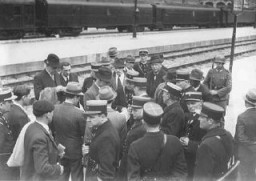
Photograph of a group of Jewish partisans. Sumsk, Poland, date uncertain.
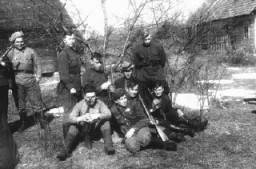
A group of Jewish women in Paris. They are wearing the required yellow badges. Paris, France, June 8, 1942.
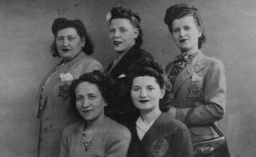
Under SA guard, a group of leading Socialists arrives at the Kislau camp, one of the early concentration camps. Local Social Democratic party leader Ludwig Marum is fourth from the left in the line of arrivals. Kislau, Germany, May 16, 1933.
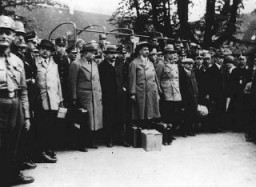
Schoolchildren wait in anticipation for the arrival of the US Ambassador to the United Nations and members of the UN Security Council, who have traveled to South Sudan to underscore their support for the January referendum on the region’s independence. October 9, 2010.
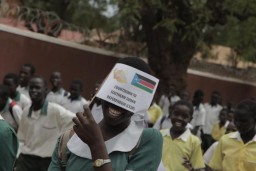
This photograph shows a group of SS officers at Solahuette, the SS retreat outside of Auschwitz. Pictured from left to right: Josef Kramer, Dr. Josef Mengele, Richard Baer, Karl Höcker, and an unidentified officer.
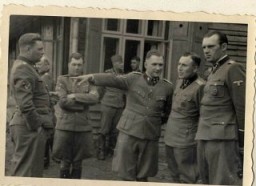
A group of SS officers socialize at an SS retreat outside Auschwitz. Pictured from left to right: Dr. Josef Mengele, Rudolf Höss, Josef Kramer, and an unidentified officer.
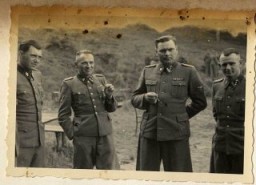
A group of Tunisian schoolgirls wearing aprons. Nadia Cohen is in the first row, third from the left. Tunis, Tunisia, ca. 1930-1935. Nadia Cohen was born on January 17, 1924, in Tunis. Nadia's parents came from Orthodox households, but her father left the yeshiva at the age of seven to study Italian, Arabic, and accounting in a French school. In 1938, Nadia was sent to a boarding school in France. She returned home for a visit in the summer of 1939 but could not return to school that fall due to the…
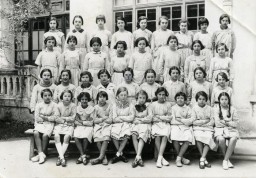
A Hitler Youth ceremony, typical of those conceived by Baldur von Schirach. They aimed to strengthen dedication to Hitler. Members recited verses, sang patriotic songs, and performed "mock funerals" for "fallen comrades." Germany, date uncertain.
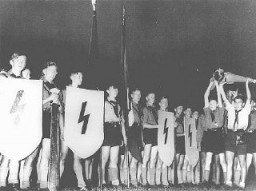
An American Jewish Joint Distribution Committee (JDC) clothing supply center for refugees. Vilna, Lithuania, 1940.
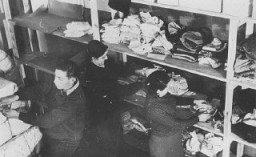
This photograph shows a Jewish boy wearing the compulsory Star of David. Prague, Czechoslovakia, between September 1941 and December 1944.
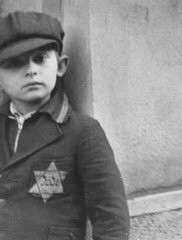
A Jewish Brigade soldier with two members of "Kibbutz Buchenwald." "Kibbutz Buchenwald" was a group of survivors from the Buchenwald concentration camp who were preparing for agricultural work in Palestine. Antwerp, Belgium, 1946.
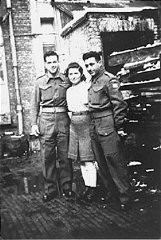
A Jewish child refugee who fled eastern Europe as part of the organized postwar flight of Jews (the Brihah). Pictured here as an apprentice at the Selvino children's home for Jewish displaced persons. Italy, October 20, 1946.
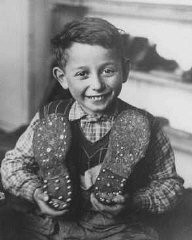
A Jewish child wears the compulsory Star of David badge with the letter "Z" for Zidov, the Croatian word for Jew. Yugoslavia, ca. 1941.
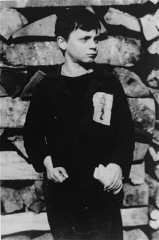
A Jewish child, Jacky Borzykowski, with the priest who placed him in hiding on a farm. Belgium, 1943.
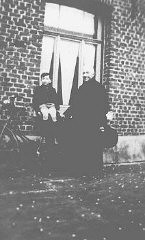
Edward Arzt, a Jewish displaced person (DP), stands at the entrance to the Cinecittà DP camp in Rome, Italy, 1947. Arzt and his family lived in the camp for three years before immigrating to the United States.
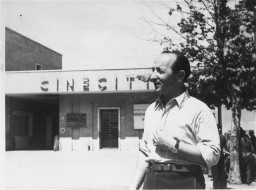
Onlookers watch as a Jewish man is forced to paint anti-Jewish graffiti on a shuttered storefront. Vienna, Austria, March 1938.
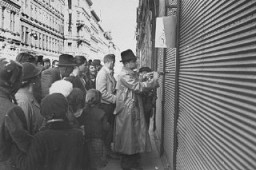
A Jewish New Year greeting card from Hela Brett, the donor's friend. In the winter of 1945-46, Rochelle Shulman (born Rochelle Szklarski), her father, and sisters left Poland with the help of the Brihah. They reached the Bad Reichenhall displaced persons camp and stayed there until February 1949, when they sailed to New York aboard the SS Marine Shark. Bad Reichenhall, Germany, September 1947.
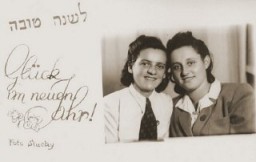
False identity card of Jewish partisan Vittorio Finzi, issued in the name of Vittorio Rossi. Italy, wartime.
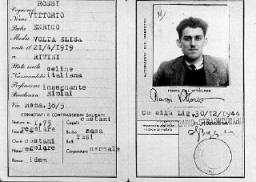
Photograph of a Jewish policeman taken during an International Red Cross visit to the Theresienstadt ghetto. The SS deceived the delegation into believing that the ghetto was a self-administered Jewish settlement. Czechoslovakia, June 23, 1944.
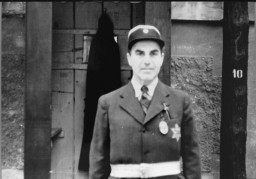
A Jewish refugee family prepares food with rations provided by the United Nations Relief and Rehabilitation Administration (UNRRA). Shanghai, China, 1946.
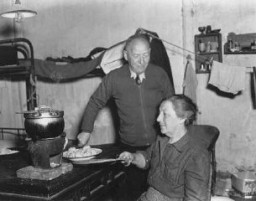
Jewish wedding in Morocco, 1942. Photo: US Holocaust Memorial Museum, courtesy of YIVO Institute for Jewish Research
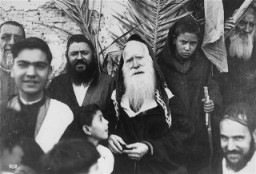
A Jewish woman during a deportation from the Warsaw ghetto. Warsaw, Poland, between October 1940 and May 1943.
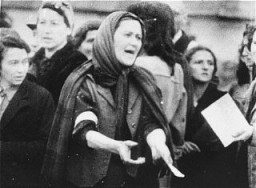
A Jewish woman carries her radio into a police station after a German order (August 8, 1941) demanded the confiscation of all radios owned by Jews. Paris, France, 1941.
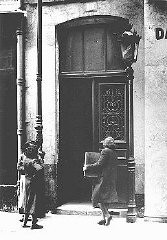
A knitwear store that was emptied and destroyed during the January 21-23 Iron Guard pogrom. Bucharest, Romania, January 1941.
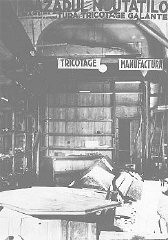
View of a mass grave in the Ohrdruf concentration camp from which 2,000 corpses were removed for proper burial. Ohrdruf, Germany, between April 20 and 25, 1945.
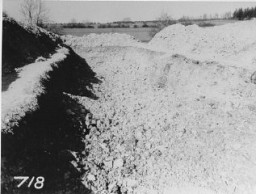
Leaders at the Wetzlar displaced persons (DP) camp hold a meeting to discuss current happenings and improvements for the camp, September 9, 1948.
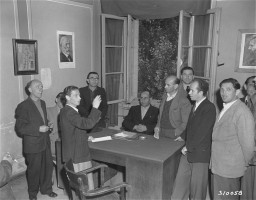
Photo taken in Secretary of State Cordell Hull's office on the occasion of the third meeting of the War Refugee Board. Hull is at the left, Secretary of the Treasury Henry Morgenthau, Jr., is in the center, and Secretary of War Henry L. Stimson is at the right. Washington, DC, United States, March 21, 1944.
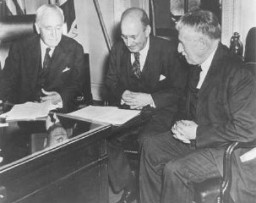
A mother checks on her sick daughter inside the container where they live in an internally displaced persons (IDP) camp near Erbil, Iraqi Kurdistan. September 1, 2015.
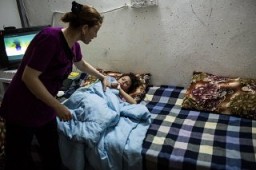
Parting from one's child was a difficult experience for parents who placed their offspring with foster families. Eda Künstler entrusted this photograph of herself to her daughter's rescuer, Zofji Sendler. On the back it is inscribed, "Anita's real mother."

The Norwegian town of Elverum, near the Swedish border, burns after a German bombing mission during the invasion of Norway. Elverum, Norway, May 3, 1940.
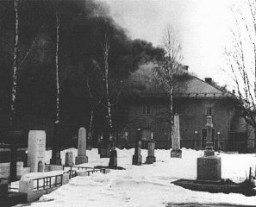
A pedestrian reads a notice announcing an upcoming public meeting, scheduled for Tuesday, December 3, to urge Americans to boycott the upcoming 1936 Berlin Olympics. New York, United States, 1935.
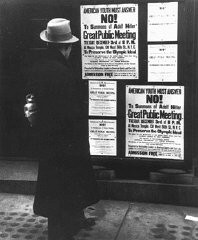
We would like to thank Crown Family Philanthropies, Abe and Ida Cooper Foundation, the Claims Conference, EVZ, and BMF for supporting the ongoing work to create content and resources for the Holocaust Encyclopedia. View the list of donor acknowledgement.